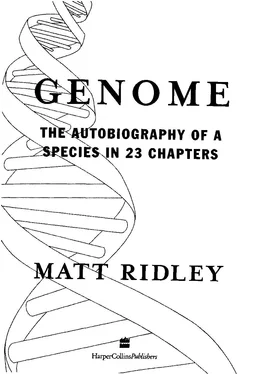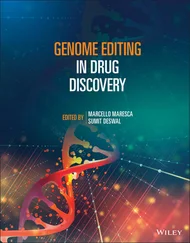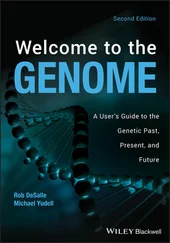Genome - Matt Ridley
Здесь есть возможность читать онлайн «Genome - Matt Ridley» весь текст электронной книги совершенно бесплатно (целиком полную версию без сокращений). В некоторых случаях можно слушать аудио, скачать через торрент в формате fb2 и присутствует краткое содержание. Жанр: Старинная литература, на английском языке. Описание произведения, (предисловие) а так же отзывы посетителей доступны на портале библиотеки ЛибКат.
- Название:Matt Ridley
- Автор:
- Жанр:
- Год:неизвестен
- ISBN:нет данных
- Рейтинг книги:5 / 5. Голосов: 1
-
Избранное:Добавить в избранное
- Отзывы:
-
Ваша оценка:
- 100
- 1
- 2
- 3
- 4
- 5
Matt Ridley: краткое содержание, описание и аннотация
Предлагаем к чтению аннотацию, описание, краткое содержание или предисловие (зависит от того, что написал сам автор книги «Matt Ridley»). Если вы не нашли необходимую информацию о книге — напишите в комментариях, мы постараемся отыскать её.
Matt Ridley — читать онлайн бесплатно полную книгу (весь текст) целиком
Ниже представлен текст книги, разбитый по страницам. Система сохранения места последней прочитанной страницы, позволяет с удобством читать онлайн бесплатно книгу «Matt Ridley», без необходимости каждый раз заново искать на чём Вы остановились. Поставьте закладку, и сможете в любой момент перейти на страницу, на которой закончили чтение.
Интервал:
Закладка:
them to decay after they reach breeding age — or, in the case of squid or Pacific salmon, to die at once. None of this makes any sense unless you view the body as a vehicle for the genes, as a tool used by genes in their competition to perpetuate themselves. The body's survival is secondary to the goal of getting another generation started. If genes are 'selfish replicators' and bodies are their disposable 'vehicles' (in Richard Dawkins's controversial terminology), then it should not be much of a surprise to find some genes that achieve their replication without building their own bodies. Nor should it be a surprise to find that genomes, like bodies, are habitats replete with their own version of ecological competition and co-operation.
Truly, in the 1970s for the first time, evolution became genetic.
To explain the fact that the genome contained huge gene-less regions, two pairs of scientists suggested in 1980 that these regions were replete with selfish sequences whose only function was survival within the genome. 'The search for other explanations may prove', they said, 'if not intellectually sterile, ultimately futile.' For making this bold forecast, they were much mocked at the time. Geneticists were still stuck in the mindset that if something were in the human genome it must serve a human purpose, not a selfish purpose of its own. Genes were just protein recipes. It made no sense to think of them as having goals or dreams. But the suggestion has been spectacularly vindicated. Genes do indeed behave as if they have selfish goals, not consciously, but retrospectively: genes that behave in this way thrive and genes that don't don't.4
A segment of selfish D N A is not just a passenger, whose presence adds to the size of the genome and therefore to the energy cost of copying the genome. Such a segment is also a threat to the integrity of genes. Because selfish D N A is in the habit of jumping from one location to another, or sending copies to new locations, it is apt to land in the middle of working genes, messing them up beyond recognition, and then jumping out again causing the mutation to revert. This was how transposons were first discovered, in the late 1940s, by the far-sighted and much neglected geneticist Barbara McClintock (she was eventually awarded the Nobel prize in 1983).
S E L F - I N T E R E S T 1 2 9
She noticed that mutations in the colour of maize seeds occur in such a manner that can only be explained by mutations jumping into and out of pigment genes.5
In human beings, L I N E - 1 s and Alus have caused mutations by landing in the middle of all sorts of genes. They have caused haemophilia, for instance, by landing in clotting-factor genes. But, for reasons that are not well understood, as a species we are less troubled by D N A parasites than some other species. Approximately 1 in every 700 human mutations is caused by 'jumping genes', whereas in mice nearly ten per cent of mutations are caused by jumping genes. The potential danger posed by jumping genes was dramatically illustrated by a sort of natural experiment in the 1950s in the tiny fruit fly, Drosophila. The fruit fly is the favourite experimental animal for geneticists. The species they study, called Drosophila melanogaster, has been transported all over the world to be bred in laboratories.
It has frequently escaped and has met other, native species of fruit fly. One of these species, called Drosophila willistoni, carries a jumping gene called a P element. Somehow in about 1950, somewhere in South America, perhaps via a blood-sucking mite, Drosophila willistoni's jumping gene entered the Drosophila melanogaster species. (One of the great concerns attached to so-called 'xeno-transplants' of organs from pigs or baboons is that they might unleash a new form of jumping gene upon our species, like the P element of fruit flies.) The P element has since spread like wildfire, so that most fruit flies have the P element, though not those collected from the wild before 1950 and kept in isolation since. The P element is a piece of selfish D N A that shows its presence by disrupting the genes into which it jumps. Gradually, the rest of the genes in the fruit fly's genome have fought back, inventing ways of suppressing the P element's jumping habit. The P elements are settling down as passengers.
Human beings possess nothing so sinister as a P element, at least not at the moment. But a similar element, called 'sleeping beauty', has been found in salmon. Introduced into human cells in the laboratory it thrives, demonstrating cut-and-paste ability. And something similar to the spread of the P element probably happened with 1 3 0 G E N O M E
each of the nine human Alu elements. Each spread through the species, disrupting genes until the other genes asserted their common interest in suppressing it, whereupon it settled down in its present fairly quiescent state. What we see in the human genome is not some rapidly advancing parasitic infection, but the dormant cysts of many past parasites, each of which spread rapidly until the genome found a way of suppressing them, but not excising them.
In this respect (as in others) we seem to be more fortunate than fruit flies. We appear to have a general mechanism for suppressing selfish D N A , at least if you believe a controversial new theory. The suppression mechanism goes by the name of cytosine methylation.
Cytosine is the letter C of the genetic code. Mefhylating it (literally by attaching a methyl group of carbon and hydrogen atoms) prevents it from being transcribed by the reader. Much of the genome spends large chunks of the time in the methylated - blocked - state, or rather most gene promoters do (the parts at the beginning of the gene where transcription starts). It has generally been assumed that methylation serves to switch off genes that are not needed in particular tissues, thus making the brain different from the liver, which is different from the skin and so on. But a rival explanation is gaining ground. Methylation may have almost nothing to do with tissue-specific expression and much to do with suppressing transposons and other intragenomic parasites. Most methylation lies within transposons such as Alu and L I N E - 1 . The new theory holds that during the early development of the embryo, all genes are briefly stripped of any methylation and switched on. This is then followed by a close inspection of the whole genome by molecules whose job is to spot repetitive sequences and close them down with methylation.
In cancer tumours, one of the first things to happen is demethylation of the genes. As a result, the selfish D N A is released from its handcuffs and richly expressed in tumours. Since they are good at messing up other genes, these transposons then make the cancer worse. Methylation, according to this argument, serves to suppress the effect of selfish D N A . 6
L I N E - 1 is generally about 1,400 'letters' long. Alu is generally S E L F - I N T E R E S T 1 3 1
at least 180 'letters' long. There are, however, sequences even shorter than Alu that also accumulate in vast, repetitive stutters. It is perhaps too far-fetched to call these shorter sequences parasites, but they proliferate in roughly the same manner - that is, they are there because they contain a sequence that is good at getting itself duplicated. It is one of these short sequences that has a practical use in forensic and other sciences. Meet the 'hypervariable minisatellite'.
This neat little sequence is found on all the chromosomes; it crops up at more than one thousand locations in the genome. In every case the sequence consists of a single 'phrase', usually about twenty
'letters' long, repeated over and over again many times. The 'word'
can vary according to the location and the individual, but it usually contains the same central 'letters': GGGCAGGAXG (where X can be any 'letter'). The significance of this sequence is that it is very similar to one that is used by bacteria to initiate the swapping of genes with other bacteria of the same species, and it seems to be involved in the encouragement of gene swapping between chromosomes in us as well. It is as if each sequence is a sentence with the words ' S W A P ME A B O U T ' in the middle.
Читать дальшеИнтервал:
Закладка:
Похожие книги на «Matt Ridley»
Представляем Вашему вниманию похожие книги на «Matt Ridley» списком для выбора. Мы отобрали схожую по названию и смыслу литературу в надежде предоставить читателям больше вариантов отыскать новые, интересные, ещё непрочитанные произведения.
Обсуждение, отзывы о книге «Matt Ridley» и просто собственные мнения читателей. Оставьте ваши комментарии, напишите, что Вы думаете о произведении, его смысле или главных героях. Укажите что конкретно понравилось, а что нет, и почему Вы так считаете.












